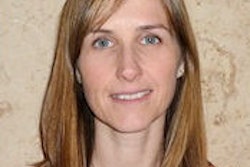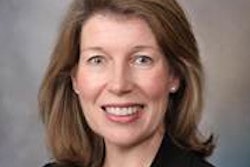In what could be a blow to the growing breast density notification movement, a new study in the Annals of Internal Medicine has found that following up women with dense breast tissue using supplemental screening ultrasound results in only limited health gains and higher healthcare costs.
Using supplemental screening ultrasound to follow up women with dense breast tissue would add $1 million to the cost of screening for every 1,000 women ages 50 to 74, and $3 million per 1,000 women ages 40 to 74.
The research comes as more states work to pass breast density notification legislation to inform women of their tissue density and encourage them to talk with their doctors about supplemental imaging -- including ultrasound and MR. Currently, 19 U.S. states have passed such legislation, and a federal version is also being considered.
Unclear effect
It's been unclear whether the breast density notification laws have had any effect -- and whether screening ultrasound is the best supplemental technology, according to Brian Sprague, PhD, of the University of Vermont, and colleagues. The American College of Radiology (ACR) and other groups have cautioned legislators, healthcare providers, and policymakers to consider the harms of this kind of legislation, such as a high rate of false positives and ensuing patient anxiety.
"The existing breast density notification laws require informing women that they have dense tissue and encouraging them to discuss supplemental screening with their doctors, but there's really no consensus about what type of supplemental screening is most helpful," Sprague told AuntMinnie.com. "We wanted to assess the benefits and harms of screening ultrasound for women with dense tissue who have had a normal mammogram."
For the study, Sprague's group used three models developed by the U.S. National Cancer Institute's (NCI) Cancer Intervention and Surveillance Modeling Network (CISNET). The study was funded by NCI. Data for the research came from the Surveillance, Epidemiology, and End Results (SEER) program, the Breast Cancer Surveillance Consortium (BCSC), and the medical literature (Ann Intern Med, December 9, 2014).
To assess the effectiveness of supplemental ultrasound, the researchers used data based on women of different screening ages and with different levels of breast density. The different strategies were as follows:
- No screening
- Biennial mammography for women ages 50 to 74
- Mammography alone
- Mammography plus ultrasound for women with extremely dense breasts
- Mammography plus ultrasound for heterogeneously and extremely dense breasts
- Annual mammography for women ages 40 to 74
- Mammography alone
- Mammography plus ultrasound for women with extremely dense breasts
- Mammography plus ultrasound for heterogeneously and extremely dense breasts
The group calculated sensitivity and specificity for digital mammography as a function of age, breast density, and screening interval using BCSC data; they used data from the American College of Radiology Imaging Network (ACRIN) 6666 trial to determine the sensitivity and specificity of screening ultrasound after a negative mammogram in women with dense breasts: 55% and 94%, respectively.
 Brian Sprague, PhD, from the University of Vermont.
Brian Sprague, PhD, from the University of Vermont.
All three models yielded similar results, according to Sprague and colleagues. Without screening, the models estimated 25.4 breast cancer deaths per 1,000 women. Biennial mammography screening alone reduced cancer deaths to 19.7 per 1,000 women for those 50 to 74 years and annual mammography alone reduced cancer deaths to 15.2 per 1,000 for those 40 to 74 years.
"Relative to no screening, these gains came at an increase in total costs of approximately $1 million per 1,000 women for biennial mammography screening for the 50 to 74 age group and $3 million per 1,000 women in the 40 to 74 age group," Sprague and colleagues wrote.
Supplemental breast ultrasound screening was also expensive in terms of quality-adjusted life years (QALYs), a standard measure for assessing the effectiveness of a screening test. Supplemental ultrasound was most cost-effective in women 50 to 74 who had extremely dense breast tissue, with a cost per QALY of $246,000 compared to using mammography alone. For women in this age group with heterogeneously and extremely dense breast tissue, supplemental ultrasound had a QALY of $325,000.
Things got even worse when younger women were included. For women ages 40 to 74 with extremely dense breast tissue, supplemental ultrasound had a cost per QALY of $553,000 compared with mammography alone, a number that ballooned to $728,000 for women with heterogeneously and extremely dense breast tissue.
So how might the findings affect clinical practice? It depends on who you're talking to, Sprague said.
"For patients, we hope our findings clarify that there's no consensus right now as to whether women with dense tissue should get imaging beyond regular mammography," he told AuntMinnie.com. "For the larger research and medical community, our results suggest that ultrasound screening is not necessarily the best solution for imaging dense breast tissue. We need to do better."
Three issues
It's important to separate the issues when analyzing this type of research, according to Dr. Regina Hooley of Yale University School of Medicine. There are three key questions: Should women be informed of their breast density? How can supplemental imaging best be done? And is the supplemental technology worth paying for?
"It's fair for women to know about their tissue density and the limitations of mammography," Hooley told AuntMinnie.com. "As for the second question: Right now, even though it's not perfect, breast ultrasound is the best supplemental modality we have -- it's readily available, it raises the cancer detection rate compared to mammography alone by about 50%, and it finds invasive cancers. With experience and more research, the performance of screening ultrasound can be improved. As for the last question, there are a lot of things we spend money on in medicine that may or may not be cost-effective, but we do it anyway because it makes sense for our patients. So why the focus on mammography and breast cancer screening?"
In any case, patients' rights are nonnegotiable, according to Nancy Cappello, PhD. Cappello launched her advocacy group, Are You Dense, in 2008 after being diagnosed with cancer following years of normal mammograms. The group was instrumental in getting the first breast density notification law passed in Connecticut in 2009.
"The purpose of these laws is to give women information that is a critical aspect of the service they're consuming, that is, medical imaging," Cappello told AuntMinnie.com. "That's separate from the technology itself. We should never withhold health information from a patient."
It can be challenging to parse which factors are most important, Sprague said.
"It's impossible to weigh lives saved versus the amount of biopsies and false positives -- saving lives is the most important outcome," Sprague said. "But it's a subjective decision about what we're willing to accept to save those lives."
Sprague's team is continuing its research, focusing on whether there are subgroups of women with dense breast tissue who would more clearly benefit from supplemental ultrasound -- such as those who also have a family history of breast cancer -- as well as investigating other promising technologies such as digital breast tomosynthesis.
"We're doing some similar simulation modeling using preliminary data on tomosynthesis, and finding that it could offer women with dense tissue more benefits and less harms than ultrasound as a screening modality," he said.




















